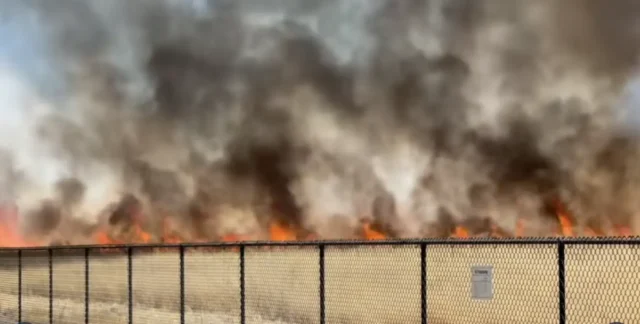On Monday, July 21, a grass fire broke out around 1:00 p.m. near the intersection of Greenville Road and Patterson Pass Road on the Lawrence Livermore National Laboratory (LLNL) Main Site in Livermore, CA. According to the Watch Duty app, the fire spread across five acres before being contained.
The weather was breezy with a high of 75 degrees and the fire appears to have spread quickly, the location of the fire was in very close proximity to LLNL’s Hazardous Waste Treatment Facility (HWTF) and the waste storage areas around it.
The HWTF is the LLNL’s facility that stores, handles and treats significant quantities of radioactive and hazardous wastes. In the Laboratory’s environmental review documents, including the 2024 Site-Wide Environmental Impact Statement for Continued Operations of LLNL, the HWTF was determined to be the location of the potential “worse-case scenario” accident of anywhere at the facility due to its large amounts of dangerous material and its proximity to the site boundary.
Given the fire’s proximity, even a small event like this serves as a wake-up call for preparedness. While the cause of Monday’s fire remains unknown at this time. Tri-Valley CAREs will be reaching out to LLNL to determine:
- Whether any ongoing cleanup or environmental monitoring programs were impacted
- If lab property was damaged, including fencing, infrastructure, or storage units
- Whether radioactive or hazardous materials were ever at risk
- What emergency protocols were enacted, and how they held up under pressure
This is not the first time fire has threatened sensitive LLNL sites. Site 300, LLNL’s high explosives testing range near Tracy, has faced similar incidents, including the 2024 Corral Fire that burned over 14,000 acres. These events are part of a larger pattern, one where climate-driven disasters are intersecting with hazardous legacy sites across the U.S.
Wildfires, worsened by drought and rising temperatures, now represent a credible threat to nuclear and national security infrastructure. Reports from the Government Accountability Office (GAO) and other watchdogs have criticized federal agencies for relying on outdated historical weather data instead of future-facing climate models.
Other NNSA nuclear weapons facilities have also had close calls with wildfires, including Los Alamos National Laboratory in New Mexico in 2000 and Pantex Plant in Texas in 2024.
As the climate crisis intensifies, fire seasons are longer, hotter, and more destructive. Yet the nation’s nuclear weapons complex, much of it aging and located in fire-prone areas, remains poorly equipped to handle these new extremes. Lawrence Livermore Lab is no exception.
As of now, Tri-Valley CAREs is calling for:
- Comprehensive Climate Risk Assessments at LLNL and all DOE sites
- Public transparency when incidents occur, even if the fire stays inside the fence line
- Up-to-date emergency planning that incorporates climate science, not just historical averages
- Independent monitoring of air, water, and soil near the lab after events like this
Our community has a right to understand the risks posed by LLNL, not only from day-to-day operations but also from the increasingly unstable climate we all inhabit. Tri-Valley CAREs will continue monitoring this situation and will report back with any findings once more details become available.
Stay tuned to Tri-Valley CAREs for more information.


Video Footage:
Para leer esta información en español HAGA CLIC AQUI!